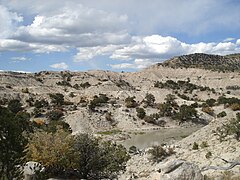| North Horn Formation | |
|---|---|
| Stratigraphic range: Maastrichtian-Danian ~ | |
 Type locality for the North Horn Formation on North Horn Mountain, Emery County, Utah | |
| Type | Geological formation |
| Underlies | Flagstaff Formation |
| Overlies | Price River & Tuscher Formations |
| Thickness | >1,100 m (3,600 ft) |
| Lithology | |
| Primary | Sandstone, shale, conglomerate |
| Other | Siltstone, limestone, coal |
| Location | |
| Coordinates | 39°00′N 111°00′W / 39.0°N 111.0°W |
| Approximate paleocoordinates | 46°48′N 88°00′W / 46.8°N 88.0°W |
| Region | Utah |
| Country | |
| Extent | ~140 km (87 mi) |
| Type section | |
| Named for | North Horn Mountain |

The North Horn Formation is a widespread non-marine sedimentary unit with extensive outcrops exposed in central and eastern Utah. The formation locally exceeds 3,600 feet (1,100 m) in thickness and is characterized by fluvial, lacustrine, and floodplain dominated systems, representing a terrestrial, high energy, depositional environment.[1][2][3] The sediments date from Late Cretaceous (Maastrichtian) to early Paleocene in age and include the K-Pg extinction event boundary; however, this boundary is extremely difficult to locate and there is no strong stratigraphic evidence available that indicates a specific marker bed such as an iridium rich clay layer.[4][5] Thus far, the only visible evidence is represented in the form of faunal turnover from dinosaur to mammal-dominated fossil assemblages. Taxa from the Cretaceous part of the formation include squamates, testudines, choristoderes, crocodyliforms, sharks, bony fishes, amphibians, mammals, dinosaurs, eggshell fragments, trace fossils, mollusks, plant macrofossils, such as wood fragments, and palynomorphs.[6][7][8][9]
- ^ Fouch, T. D., Lawton, T. F., Nichols, D. J., Cashion, W. B., Cobban, W. A. (1983). Patterns and timing of synorogenic sedimentation in Upper Cretaceous rocks of central and northeast Utah. In Reynolds, M. W., and Dolly, E. D., eds., Mesozoic paleogeography of west central United States. Society of Economic Paleontologists and Mineralogists. Pp. 305-336.
- ^ Lawton, T. F. (1986). Fluvial systems of the Upper Cretaceous Mesaverde Group and Paleocene North Horn Formation, central Utah: A record of transition from thin-skinned to thick-skinned deformation in the foreland region. Paleotectonics and Sedimentatio in the Rocky Mountain Region, United States. AAPG Special Volumes, M 41. Pp. 423-442.
- ^ Lawton, T. F., Talling, P. J., Hobbs, R. S., Trexler, J. H. Jr, Weiss, M. P., Burbank, D. W. (1993). Structure and stratigraphy of Upper Cretaceous and Paleocene strata (North Horn Formation), eastern San Pitch Mountains, Utah – sedimentation at the front of the Sevier orogenic belt. United States Geological Survey, Bulletin 1787-II, Pp. 1-33.
- ^ Difley, R., Ekdale, A. A. (2002). Faunal implications of an environmental change before the Cretaceous-Tertiary (K-T) transition in central Utah. Cretaceous Research, 23:315-331.
- ^ Myung-Suk, Y., Cross, A.T. (1997). Palynostratigraphy of Upper Cretaceous-Lower Tertiary strata, Price Canyon, Utah. Review of Palaeobotany and Palynology 97, p.53-66
- ^ Cite error: The named reference
G46was invoked but never defined (see the help page). - ^ Cifelli, R.L., Czaplewski, N.J., Rose, K.D. (1995). Knowledge of Paleocene Mammals from the North Horn Formation, Central Utah. The Great Basin Naturalist. Vol. 55:4. Pp. 304-314
- ^ Cifelli, Richard L.; Nydam, Randall L.; Eaton, Jeffrey G.; Gardner, James D.; Kirkland, James I. (1999). "Vertebrate faunas of the North Horn Formation (Upper Cretaceous–Lower Paleocene), Emery and Sanpete Counties, Utah". In Gillette, David D. (ed.). Vertebrate Paleontology in Utah. Salt Lake City: Utah Geological Survey. pp. 377–388. ISBN 1-55791-634-9.
- ^ Difley, Rose L.; Ekdale, Allan A. (August 2002). "Footprints of Utah's Last Dinosaurs: Track Beds in the Upper Cretaceous (Maastrichtian) North Horn Formation of the Wasatch Plateau, Central Utah". PALAIOS. 17 (4): 327–346. Bibcode:2002Palai..17..327D. doi:10.1669/0883-1351(2002)017<0327:FOUSLD>2.0.CO;2. JSTOR 3515759. S2CID 130309439. Retrieved 18 October 2020.

